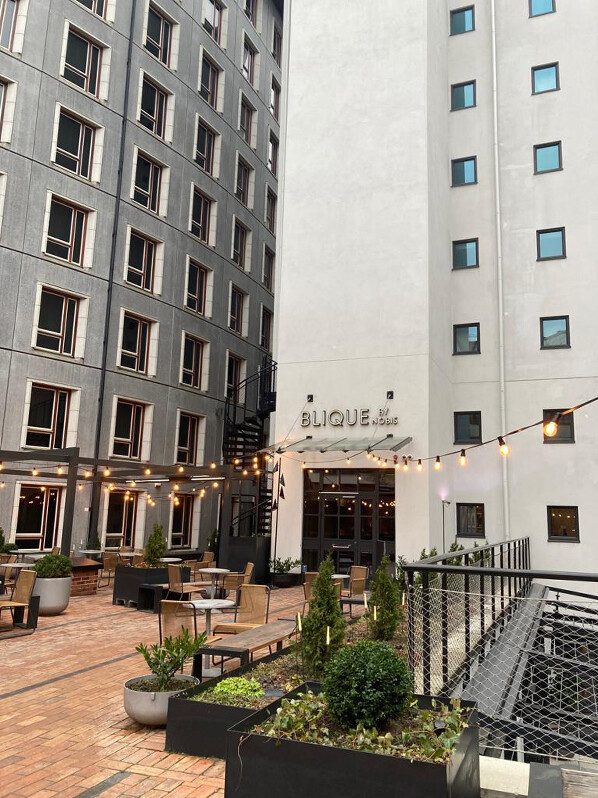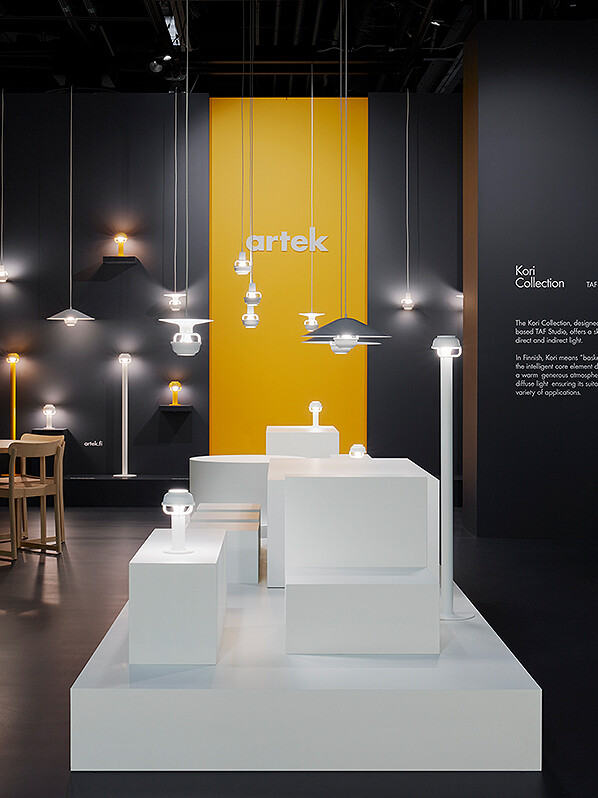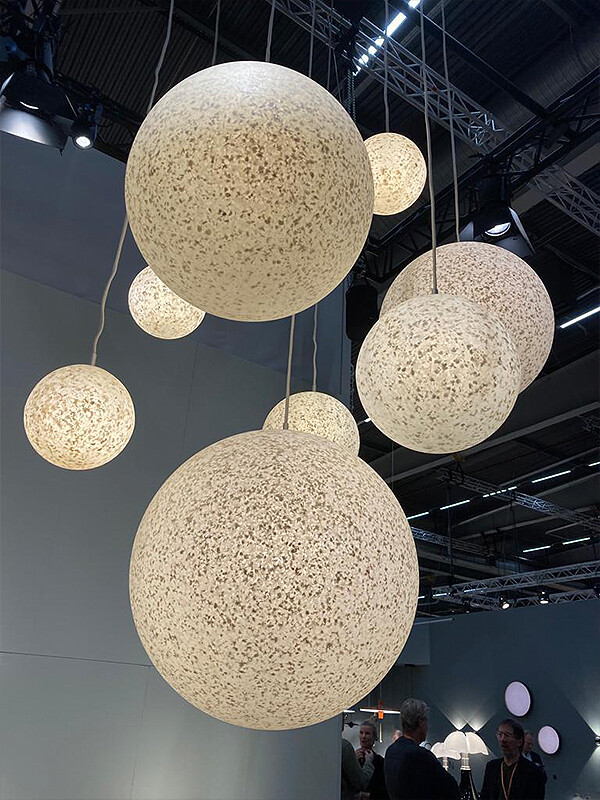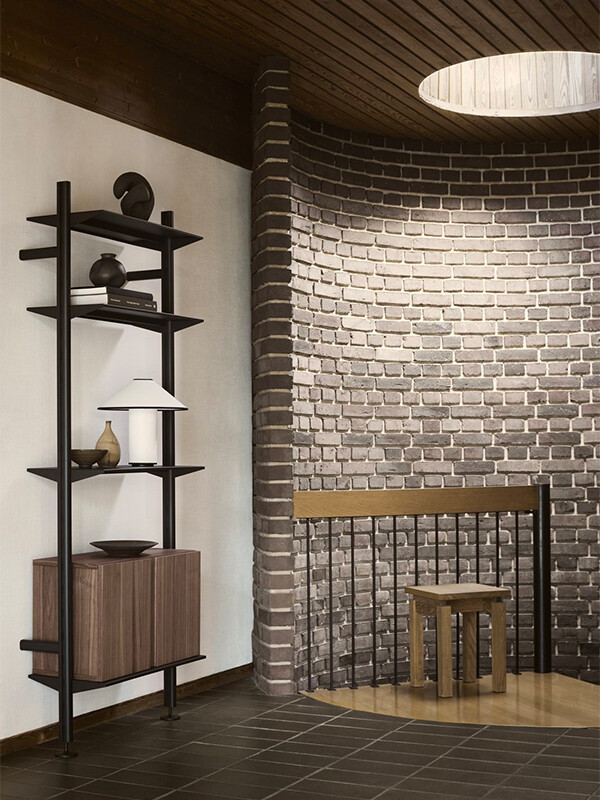
Stockholm Design Week 2023: Our highlights
Kicking off Nest’s design events for 2023, we travelled to Sweden for the annual Stockholm Design Week.
Coinciding with Stockholm’s Furniture Fair, the design week brings together designers, architects, and enthusiasts worldwide to showcase contemporary design trends and innovations.
This year, some of our team had the pleasure of attending and exploring the work of some of the industry’s most innovative brands.
Sustainability in Stockholm
Known for its focus on sustainability and environmentally responsible design practices, Stockholm Design Week was full of exhibitors and speakers stressing the importance of using eco-friendly materials and minimising waste and energy consumption. During our time in the city, we saw a keen emphasis on using recycled and repurposed materials. Brands debuted new and updated collections made from recycled plastic waste.
Aligning with this focus, Normann Copenhagen demonstrated its characteristic ability to repurpose plastic waste into beautiful interior pieces. Known for the distinctive Bit Stool with its pixelated surface, Normann Copenhagen translates the unique effect into a striking lampshade. Mixing various shades of white plastic waste, the Pix lampshade showcases the ability to work with recycled materials in contemporary ways, appearing opaque when turned off while obtaining a translucent look when turned on.
Designing for adaptability and longevity was another sustainability trend on show at Stockholm Design Week. Exhibitors emphasised the importance of creating products that can be easily repaired or adapted for different uses rather than being discarded and replaced.
For example, exhibitors like String showcased their popular modular furniture systems that can be reconfigured and adapted over time. With a big focus on the smallest configuration from the modular String series, the versatile Pocket embodied a sense of fun and vitality with four bold new nuances. Fixed upon a simple white backdrop, the String arrangements captured our attention instantly.
Alongside the vibrant colourways, String took the opportunity to introduce the Pira G2. A contemporary interpretation, the Pira G2 relaunches the Olle Pira 1954 classic by architect Anna won Schewen and industrial designer Björn Dahlström.
SFF Guest of Honour: Front
Design studio Front received the Stockholm Furniture Fair Guest of Honour award for 2023, marking the first time a Swedish brand received the honour since the fair’s inception.
Contemporary and highly unique, Front has grown exponentially since the founding duo first exhibited at the fair 19 years ago. Producing timeless pieces with a comprehensive attitude towards their work, Front has since collaborated with the likes of Vitra, Swedese, GAN and Moooi, challenging conventions within the design field.
Marking their guest of honour recognition, Front displayed their forward-thinking nature with a fascinating installation that combines the traditional techniques of weaving and embroidery with technology.
The innovative exhibition perfectly highlights Front’s enduring fascination with nature and gives a unique insight into the studio’s work.
Scandinavian showstoppers
Drawing a large crowd from around the world, Stockholm Furniture Fair is the meeting place for some of the most admired Scandinavian designer brands, with about 80% coming from the Scandinavian countries.
The perfect opportunity to glimpse upcoming releases and prototypes, we were lucky enough to see some of our favourite brands and their newest products.
Known for its signature modernist style and commitment to sustainable design, the Artek stand at the Stockholm Design Fair was a must-see.
Alongside the brand’s well-known pieces, Artek took the opportunity to showcase the launch of the Kori collection. Designed in collaboration with Stockholm-based TAF Studio, the Kori pieces offer a skilful interplay of direct and indirect light within the unique basket-like design. Available in a deep matte white, the fair provided an excellent opportunity to see the collection up close and in person.
Ilse Crawford: Reality is something we make
In addition to the beautiful exhibits and installations, Stockholm Design Week also featured a series of talks and discussions on topics related to design and sustainability.
Speakers included designers, architects, and other industry experts, who shared their insights and experiences on a range of topics. We were lucky enough to attend the Ilse Crawford talk ‘Reality is something we make’, where the revered designer discussed the impact design has on our lives and health. Using a recent Studioilse community kitchen project as an example, Crawford explained how her team aimed to bring the universal pleasure that shared spaces often overlook.
Did you attend Stockholm Design Week 2023? We’d love to hear about your favourite moments! Share your thoughts and images with us on Instagram @nest_co_uk.
Stockholm Design Week 2023: Our highlights

Kicking off Nest’s design events for 2023, we travelled to Sweden for the annual Stockholm Design Week.
Coinciding with Stockholm’s Furniture Fair, the design week brings together designers, architects, and enthusiasts worldwide to showcase contemporary design trends and innovations.
This year, some of our team had the pleasure of attending and exploring the work of some of the industry’s most innovative brands.
Sustainability in Stockholm
Known for its focus on sustainability and environmentally responsible design practices, Stockholm Design Week was full of exhibitors and speakers stressing the importance of using eco-friendly materials and minimising waste and energy consumption. During our time in the city, we saw a keen emphasis on using recycled and repurposed materials. Brands debuted new and updated collections made from recycled plastic waste.
Aligning with this focus, Normann Copenhagen demonstrated its characteristic ability to repurpose plastic waste into beautiful interior pieces. Known for the distinctive Bit Stool with its pixelated surface, Normann Copenhagen translates the unique effect into a striking lampshade. Mixing various shades of white plastic waste, the Pix lampshade showcases the ability to work with recycled materials in contemporary ways, appearing opaque when turned off while obtaining a translucent look when turned on.
Designing for adaptability and longevity was another sustainability trend on show at Stockholm Design Week. Exhibitors emphasised the importance of creating products that can be easily repaired or adapted for different uses rather than being discarded and replaced.
For example, exhibitors like String showcased their popular modular furniture systems that can be reconfigured and adapted over time. With a big focus on the smallest configuration from the modular String series, the versatile Pocket embodied a sense of fun and vitality with four bold new nuances. Fixed upon a simple white backdrop, the String arrangements captured our attention instantly.
Alongside the vibrant colourways, String took the opportunity to introduce the Pira G2. A contemporary interpretation, the Pira G2 relaunches the Olle Pira 1954 classic by architect Anna won Schewen and industrial designer Björn Dahlström.
SFF Guest of Honour: Front
Design studio Front received the Stockholm Furniture Fair Guest of Honour award for 2023, marking the first time a Swedish brand received the honour since the fair’s inception.
Contemporary and highly unique, Front has grown exponentially since the founding duo first exhibited at the fair 19 years ago. Producing timeless pieces with a comprehensive attitude towards their work, Front has since collaborated with the likes of Vitra, Swedese, GAN and Moooi, challenging conventions within the design field.
Marking their guest of honour recognition, Front displayed their forward-thinking nature with a fascinating installation that combines the traditional techniques of weaving and embroidery with technology.
The innovative exhibition perfectly highlights Front’s enduring fascination with nature and gives a unique insight into the studio’s work.
Scandinavian showstoppers
Drawing a large crowd from around the world, Stockholm Furniture Fair is the meeting place for some of the most admired Scandinavian designer brands, with about 80% coming from the Scandinavian countries.
The perfect opportunity to glimpse upcoming releases and prototypes, we were lucky enough to see some of our favourite brands and their newest products.
Known for its signature modernist style and commitment to sustainable design, the Artek stand at the Stockholm Design Fair was a must-see.
Alongside the brand’s well-known pieces, Artek took the opportunity to showcase the launch of the Kori collection. Designed in collaboration with Stockholm-based TAF Studio, the Kori pieces offer a skilful interplay of direct and indirect light within the unique basket-like design. Available in a deep matte white, the fair provided an excellent opportunity to see the collection up close and in person.
Ilse Crawford: Reality is something we make
In addition to the beautiful exhibits and installations, Stockholm Design Week also featured a series of talks and discussions on topics related to design and sustainability.
Speakers included designers, architects, and other industry experts, who shared their insights and experiences on a range of topics. We were lucky enough to attend the Ilse Crawford talk ‘Reality is something we make’, where the revered designer discussed the impact design has on our lives and health. Using a recent Studioilse community kitchen project as an example, Crawford explained how her team aimed to bring the universal pleasure that shared spaces often overlook.
Did you attend Stockholm Design Week 2023? We’d love to hear about your favourite moments! Share your thoughts and images with us on Instagram @nest_co_uk.








